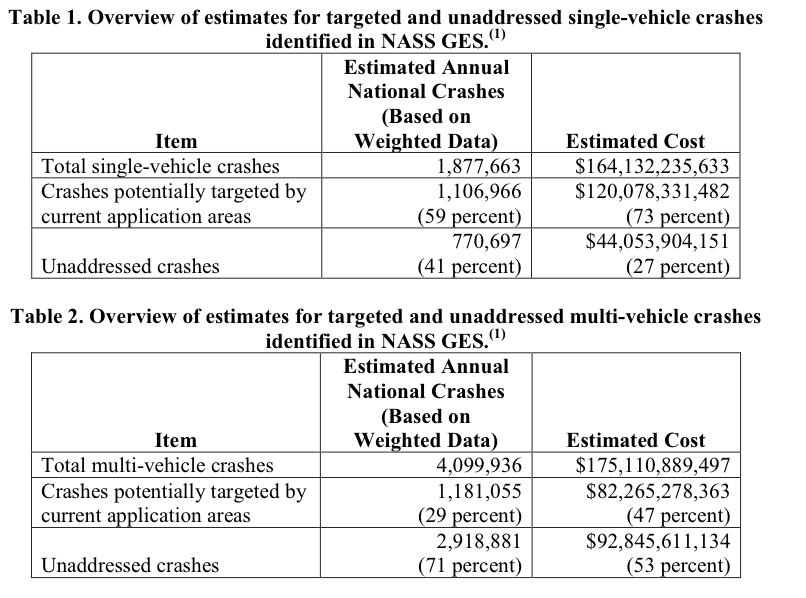FEDERAL HIGHWAY ADMINISTRATION
Executive Summary
The United States Department of Transportation (USDOT) Intelligent Transportation System (ITS) Strategic Plan has the potential to transform travel through safety, mobility, and environmental improvements in surface transportation. Two major programs under this plan are the Vehicle-to-Infrastructure (V2I) and Vehicle-to-Vehicle (V2V) Communications for Safety Initiatives. Both programs are composed of technologies and application areas that use wireless communication to enhance connectivity within the surface transportation network. This report focuses on the potential safety benefits of wireless communication between the roadway infrastructure and vehicles. Specifically, it identifies the magnitude, characteristics, and cost of crashes that would be targeted with currently proposed V2I for safety application areas that have been identified by USDOT with stakeholder input. It also identifies the magnitude, characteristics, and cost of the remaining crashes that are not targeted by a currently proposed V2I for safety application area (unaddressed crashes) for insight into potentially new applications or modifications to proposed applications. The V2I applications investigated in this study comprise four areas: (1) intersection safety, (2) speed management, (3) vulnerable road users, and (4) other safety application areas.
The primary analysis was conducted using the National Automotive Sampling System General Estimates System (NASS GES) database, which provides a national estimate of crashes by weighting a sample of crashes.(1) Other databases, including the Highway Safety Information System (HSIS) and the Fatality Analysis Reporting System (FARS), were used to supplement the NASS GES analysis.(2,3) Pre-crash1 scenarios, developed through previous efforts, were used to define each crash in the NASS GES database from 2005 to 2008.(1) The frequency and severity of crashes in each pre-crash scenario were summarized, and total costs were assigned to each scenario based on the severity of crashes. Pre-crash scenarios were associated with the respective V2I application areas, and crash frequencies and associated costs were totaled within each application area to determine the potential safety benefits.
Table 1 and table 2 present an overview of the findings from the NASS GES analysis for single- vehicle and multi-vehicle crashes. The tables provide annual data averaged over a 4-year period from 2005 to 2008. Specifically, they present the total annual crashes nationally, the subset of those crashes that would be targeted by current V2I application areas, and the remaining unaddressed crashes. Unaddressed crashes are calculated by subtracting the crashes that would be targeted by current application areas to those application areas from the total number of annual crashes. The associated cost for each group of crashes is also shown in the tables. Note that there is some overlap in the crashes targeted by the application areas. This overlap is accounted for in table 1 and table 2.
NASS GES estimates that approximately 6 million crashes (including both single- and multi- vehicle crashes) occurred each year from 2005 to 2008, totaling more than $339 billion in annual crash costs.(1) The total annual cost for single-vehicle crashes was $164 billion. The leading single-vehicle pre-crash scenarios were control loss/no vehicle action, road edge departure/no maneuver, and pedestrian/no maneuver. Collectively, these three scenarios represented73 percent of the costs for single-vehicle crashes.
The total annual cost for multi-vehicle crashes was $175 billion. The leading multi-vehicle pre-crash scenarios were straight crossing path at non-signal, rear-end/lead vehicle stopped (LVS), and opposite direction/no maneuver. Collectively, these three scenarios represented 45 percent of the total costs for multi-vehicle crashes.
Currently identified V2I safety application areas could potentially target approximately 2.3 million crashes and $202 billion in costs. The remaining unaddressed crashes represent approximately 3.7 million crashes, totaling approximately $137 billion annually.
These unaddressed crashes represent potential targets for new V2I applications and are presented in this report by pre-crash scenario within single- and multi-vehicle categories. For single- vehicle crashes, pedestrian/no maneuver was the leading unaddressed pre-crash scenario, followed by bicyclist/no maneuver and animal/no maneuver. Collectively, these scenarios represented 56 percent of the costs of unaddressed single-vehicle crashes. From a practical perspective, V2I applications developed to mitigate these crashes would need to be carefully targeted due to the large number of potential miles for treatment.
The leading unaddressed multi-vehicle pre-crash scenario was rear-end/LVS, followed by straight crossing path at non-signal and left turn across path/opposite direction at non-signal. Collectively, these scenarios represented 50 percent of the costs of unaddressed multi-vehicle crashes. Although these scenarios represented a large potential target for V2I applications, a primary concern is whether these scenarios might be better addressed by autonomous vehicle (AV) or V2V communication applications.
The results indicated that the currently identified V2I safety applications discussed in this report are well conceived and can potentially treat large portions of the country’s crashes and crash costs. However, there are many crashes that are not addressed by the applications analyzed in this report. The characteristics of unaddressed crashes that are presented in this report provide a starting point for identifying new applications or modifications to current applications.
Read full report (PDF) here: Crash Data Analyses for Vehicle-to-Infrastructure Communications
About The Federal Highway Administration (FHWA)
www.fhwa.dot.gov
“The Federal Highway Administration (FHWA) is an agency within the U.S. Department of Transportation that supports State and local governments in the design, construction, and maintenance of the Nation’s highway system (Federal Aid Highway Program) and various federally and tribal owned lands (Federal Lands Highway Program). Through financial and technical assistance to State and local governments, the Federal Highway Administration is responsible for ensuring that America’s roads and highways continue to be among the safest and most technologically sound in the world.”
Tags: Communications, Crash Data Analyses, Federal Highway Administration, FHWA, Safety Applications, Vehicle-to-Infrastructure







 RSS Feed
RSS Feed